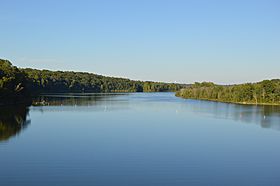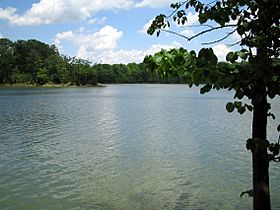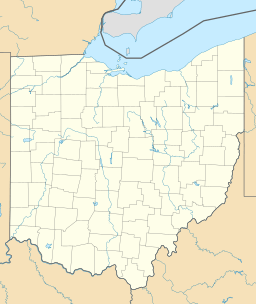Caesar Creek State Park facts for kids
Caesar Creek State Park is a fun outdoor area in southwestern Ohio. It's about five miles (8 km) east of Waynesville. This park covers parts of Warren, Clinton, and Greene counties.
The park is managed by the State of Ohio. However, the land is actually owned by the U.S. Army Corps of Engineers. In the 1970s, they built a large dam on Caesar Creek. This dam created a big lake, which is 2,830 acres (1,145 ha) in size. The whole park, including the lake, is about 7,530 acres (3,047 ha). It's a great place for many outdoor activities!
Quick facts for kids Caesar Creek State Park |
|
|---|---|
 |
|
| Lua error in Module:Location_map at line 420: attempt to index field 'wikibase' (a nil value). | |
| Location | Clinton, Greene & Warren counties, Ohio, United States |
| Area | Land: 4,700 acres (1,900 ha) Water: 2,830 acres (1,150 ha) |
| Elevation | 843 ft (257 m) |
| Established | 1978 |
| Administered by | Ohio Department of Natural Resources |
| Designation | Ohio state park |
| Website | Caesar Creek State Park |
| Caesar Creek Lake | |
|---|---|
 |
|
| Location | Warren / Clinton counties, Ohio, United States |
| Coordinates | 39°29′07″N 84°03′55″W / 39.48528°N 84.06528°W |
| Lake type | Reservoir |
| Primary inflows | Caesar Creek |
| Primary outflows | Caesar Creek |
| Basin countries | United States |
| Max. length | 6.4 miles (10.3 km) |
| Max. width | 1.5 miles (2.4 km) |
| Surface area | 2,830 acres (1,150 ha) |
| Shore length1 | 36.3 miles (58.4 km) |
| Surface elevation | 797 ft (243 m) |
| 1 Shore length is not a well-defined measure. | |
Contents
Fun Things to Do at Caesar Creek State Park
Caesar Creek State Park offers many exciting activities for visitors. You can explore nature, learn about history, and enjoy the beautiful lake.
Explore the Trails
The park has many trails for different activities.
- There are 43 miles (69 km) of trails perfect for hiking.
- If you like horseback riding, there are 31 miles (50 km) of bridle trails.
Step Back in Time at Caesar's Creek Pioneer Village
This village is a special part of the park.
- It has more than 15 old log cabins and other buildings.
- These buildings are open during special events.
- A private group helps keep the village running.
- You can see a Quaker meetinghouse, a broom shed, and an old schoolhouse.
- There's also a blacksmith shop, a carpenter shop, and a toll house.
- Many family homes from the past are also there to explore.
Learn at the Caesar Creek Nature Center
Right next to the Pioneer Village, you'll find the nature center.
- It has cool exhibits about the area's history and nature.
- They offer nature programs all year long.
- You can join campouts, hikes, and even a program about making maple syrup!
About the Caesar Creek Dam
The dam at Caesar Creek is a very important structure. It helps control water levels and prevent floods.
How the Dam Was Built
The dam is made of earth and rock.
- It stands 165 feet (50 m) high.
- It stretches 2,750 feet (838 m) long.
- Construction on the dam started in 1971.
- It was completed and ready by 1978.
- The land area managed by the Army Corps of Engineers around the dam is 10,550 acres (4,270 ha).
Why the Dam is Important
The U.S. Army Corps of Engineers built and manages Caesar Creek Lake.
- Congress approved the lake in 1938 to help prevent floods.
- During fall and winter, the lake's water level is lowered. This makes room for heavy spring rains.
- If there's a lot of rain, the lake stores the extra water.
- Once the rivers below the dam are safe, the stored water is slowly released. This helps protect homes and lives from flooding.
- The dam is located in Massie and Wayne townships in Warren County.
The Story of New Burlington
When Caesar Creek Lake was created, it covered a small farming village.
- The village was called New Burlington, Ohio.
- It was flooded in 1973 to make way for the lake.
- The history of this community was gathered in a book.
- The book is called New Burlington: The Life and Death of an American Village.
- It was written by John Baskin.
- The book shares stories, letters, and journals from the people who lived there.


